Abstract
For the last two decades, autonomous vehicles have been proposed and developed to extend the operational design domain from the motorway to urban environments. However, there have been few studies on autonomous driving for uncontrolled and blind intersections. This paper presents a proactive motion planning algorithm to enhance safety and traffic efficiency simultaneously for autonomous driving in uncontrolled blind intersections. The target states of approach motion are decided based on the field of view of the laser scanner and the pre-defined intersection map with connectivity information. The model predictive controller is used to follow the target states and determine the longitudinal motion of an autonomous vehicle. A Monte Carlo simulation with a case study was conducted to evaluate the performance of the proposed proactive motion planner. The simulation results show that the risk caused by approaching vehicles from the occluded region is properly managed. In addition, the traffic flow is improved by reducing the required time to cross the intersections.
1. Introduction
Advanced driver assistance systems (ADASs) have become one of the most popular features of the automotive industry [1]. ADASs have led to the improvement of convenience and safety by automating a part of the driving tasks and providing warnings to avoid dangerous situations. Based on the current achievements of ADASs, the ADAS has evolved to mass production of level three autonomous driving for motorways [2]. Recently, research for autonomous driving has expanded its operational design domain from motorways to urban roads and increased automation level toward level four, which is the fully autonomous driving system. The element technologies for autonomous driving such as perception, localization, decision, and control are evolving to cope with complex driving scenarios [3]. Among the urban driving scenarios, an intersection is one of the risky driving areas on urban roads. Especially, an uncontrolled intersection with a blind spot is a difficult diving scenario, because there are no traffic signals to provide access management for the traffic [4]. Inappropriate approach motion to uncontrolled intersections increases the probability of accidents with other approaching vehicles [5]. According to the Federal Highway Administration, which is a division of the U.S. Department of Transportation in Washington, D.C., about 67.3% of fatalities at U.S. intersections in 2018 occurred at unsignalized intersections [6]. Therefore, the important issue in order to achieve safety at the uncontrolled blind intersection is the planning of the intersection approach motion.
Many studies have been conducted to provide the driver assistance function at intersections. The Time to Collision (TTC)-based intersection assistance system considering computational latency and response modalities was proposed and evaluated using the crash scenarios collected by crash investigators [7]. A threat assessment algorithm using rapidly exploring random trees was designed to warn the driver crossing a road intersection [8]. In addition, communication-based intersection assistance was proposed and showed effectiveness with respect to the equipment ratio of inter-vehicle communication [9]. An intersection management system from the perspective of traffic engineering was developed for the vehicle equipped with adaptive cruise control [10]. Centralized control approach for intersection management was applied to vehicles with cooperative adaptive cruise control [11].
The research trends have been extended to motion planning for intersection passing to manage the risk caused by target vehicles coming from other entrances of the intersection. A Markov decision process (MDP) was used to model the behavior of the target vehicles [12]. However, in practice, it is difficult to measure all states for constructing an MDP. Thus, a partially observable Markov decision process (POMDP) was utilized to design a decision-making algorithm for passing through intersections [13,14,15]. In particular, POMDP was used with a path based on the critical turning point [16]. A support vector machine (SVM)-based driving mode decision and motion planner was proposed for autonomous driving at uncontrolled intersections [17]. The robust model predictive controller (MPC) was utilized to find safe time gaps in traffic streams [18]. The cooperative driving strategy was proposed to avoid a collision by solving optimization problems [19]. Communication technologies have been utilized to derive the motion planning algorithm for intersection scenarios. The rule-based control algorithm was developed on the assumption that all approaching vehicles are connected vehicles. [20]. In particular, priority-based decentralized intersection management was proposed under the assumption that all vehicles are connected [21]. In addition, the space–time block-based scheduling for the connected autonomous vehicle was proposed with an additional controller to respond to unexpected obstacles [22]. The centralized management was designed by using the conflict matrix, which shows the conflict between all possible driving routes [23]. Since the connected vehicle can share all the information, reinforcement learning can be used to design a velocity controller [24]. To analyze the applicability of communication-based intersection motion planners in real-road situations, a study was conducted assuming that the 5G network is used to construct the vehicle-to-vehicle communication [25]. The motion planner based on the finite state machine was proposed to select the driving strategies by using the information from connected vehicles [26]. The concept of virtual platooning was proposed to provide cooperative intersection control [27]. The optimization-based intersection control system was developed based on vehicle-to-vehicle communication [28].
Many of the studies mentioned so far have assumed that information on the target vehicles is given. To receive the target information from the blind spots, the sensors were installed on the infrastructure [29]. However, obtaining all target information is a difficult assumption in an urban environment. Therefore, a proactive strategy was utilized for urban autonomous driving in previous studies. The trajectory generation and speed control for proactive motion planning was proposed to respond to pedestrians [30] and preceding vehicles [31]. Proactive driving for blind intersections was modeled to provide a smooth and comfortable driving pattern for autonomous vehicles [32,33]. To define the safe approaching motion, the visibility graph was used to define the possible collision moment in intersections [34]. A game tree-based proactive motion planner was designed and evaluated for a left-turning scenario [35]. Similarly, game-theoretic modeling was used to model negotiation of uncontrolled intersections [36]. Reinforcement learning was applied to provide an efficient strategy for occluded intersections [37,38,39,40,41].
As described in the previous studies, there have been two categories to develop the motion planner for intersections. The first is developing the motion-planning algorithm for intersection passing based on the given target information. The second is providing the proactive approaching motion for specific scenarios, for example, a left-turning scenario. However, there have been few approaches that designed a proactive motion planner for uncontrolled blind intersections based on the information from environment sensors on the autonomous vehicle and digital maps. Therefore, it is necessary to develop an approach-motion planner for uncontrolled blind intersections and evaluate the proposed algorithm under various driving scenarios in multi-vehicle driving conditions.
In this paper, the proactive motion planning algorithm for uncontrolled blind intersections is proposed and evaluated. The proactive motion planner decides the desired longitudinal acceleration of the autonomous vehicle until detecting the target vehicle. After detecting the target vehicles, the interaction motion is decided by using the previous work [42]. The motion planner consists of an approach-motion decision and target state tracking modules. The approach-motion decision module determines the target states of the autonomous vehicle by considering the field of view (FOV) of sensors, calculation delay, and actuator performance. The determined target states are tracked by a longitudinal motion controller using MPC to calculate the longitudinal acceleration input. The effectiveness of the proposed algorithm was evaluated by the Monte Carlo simulation with respect to safety and traffic efficiency.
The contributions of this paper are summarized as follows:
- The proposed algorithm provides human-like behavior when approaching the uncontrolled intersection to avoid an inevitable collision with targets deriving from blind spots. The concept of the virtual conflict point and the proactive zone is proposed to realize proactive motion planning in uncontrolled intersections.
- The proactive motion planner is designed based on the FOV of sensors, which is estimated by using the intersection map and static obstacle map. Therefore, the proposed algorithm can utilize various types of sensors capable of constructing a static obstacle map.
- The MPC is used to determine the optimal longitudinal acceleration to follow the target states while minimizing the change in the behavior of the vehicle. Thus, the target state tracker prevents excessive control inputs.
This paper is organized as follows: Section 2 explains the overall architecture of the proposed proactive motion planner for uncontrolled blind intersections. Because the driving situation of intersections is quite different from nominal driving conditions such as a motorway, modified safety parameters for proactive motion planning are described in the same section. The target state decision algorithm and tracker are explained in Section 3. The simulations for the case study and Monte Carlo simulation are carried out in Section 4 and the results are summarized in Section 5. The conclusions of this study are drawn in Section 6.
2. Overall Architecture of Proactive Motion Planner
This study focuses on the design and evaluation of a proactive motion planner for uncontrolled blind intersections on urban roads. The objective of this study is to determine the desired longitudinal acceleration of the autonomous vehicle to improve safety and flow efficiency when passing uncontrolled blind intersections. The overall architecture of the proactive motion planner is described in Figure 1. As shown in Figure 1, the upper modules were utilized to provide the information for the proposed algorithm. In this study, vehicle filter, localization, and target detection module were used to obtain the states of the autonomous vehicle and surrounding targets. The route planner and intersection map were utilized to acquire the global driving route of the autonomous vehicle and the possible driving route of other vehicles.

Figure 1.
The overall architecture of the proactive motion planner for uncontrolled blind intersections.
The information from the upper modules and sensors was used to configure the algorithm. The proposed algorithm consists of three modules, a driving mode decision, a target state decision, and an MPC-based target state tracker. The driving mode decision algorithm estimates the FOV of the sensors and checks the detection of approaching targets from other branches of the intersection. The target states for the approach and interaction modes are determined by the target state decision module using the concepts of the virtual conflict point. Then, the target states are used as reference states for MPC to obtain the desired longitudinal acceleration.
As mentioned in Section 1, many pieces of research have been carried out to develop the motion-planning algorithm for urban autonomous driving. Especially, motion planner for intersection passing has been studied recently. However, the conventional safety parameters, such as clearance (C), TTC, headway time, or time gap are hard to utilize for intersection driving scenarios, because the paths of the approaching vehicles are crossed inside the intersection, and the driving directions are opposite each other. In order to overcome the limitations of the conventional safety parameters, the safety parameters are defined as shown in Figure 2. dDTI means the remaining distance to enter the intersection. dDTC means the distance to the conflict point, which is defined as a cross point between driving routes for host and target vehicles. In this study, the summation of the dDTC,host and dDTC,target are used to define C. Based on the dDTI and dDTC, C, time to intersection (TTI), and TTC for intersection motion planner is calculated as follows:
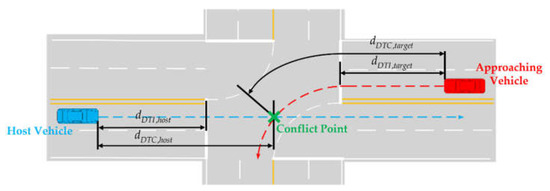
Figure 2.
Parameter definition for intersection motion planning.
Equation (1) considers the host and target vehicle states with the shape of the intersection. In order to estimate the possible driving path of the approaching targets, an intersection map is required to provide the available maneuvers of each driving lane. An example of the four-way intersection is shown in Figure 3. The center line of the road is marked with a solid yellow line, and the lane marker is marked with a black dotted line in Figure 3. As shown in Figure 3, the entry and exit nodes of each driving lane are marked as red and blue circles, respectively. The indices of the nodes are assigned a number from 1 to 8. The driving paths inside the intersection are virtually generated using the B-spline to smoothly connect the entry and exit nodes. The example driving paths from entering nodes 1 and 2 are depicted as a magenta and cyan solid line. Connectivity between each node is defined using the connectivity matrix Ccon, as follows:
The (i, j) component of Ccon indicates the connectivity between the i-th entry node and j-th exit node, which has a value from 0 to 3. ‘Not connected’, ‘going straight’, ‘left turning’, and ‘right turning’ correspond to values of 0, 1, 2, and 3, respectively. The definition of Ccon can be extended to more complex intersections and roundabouts.
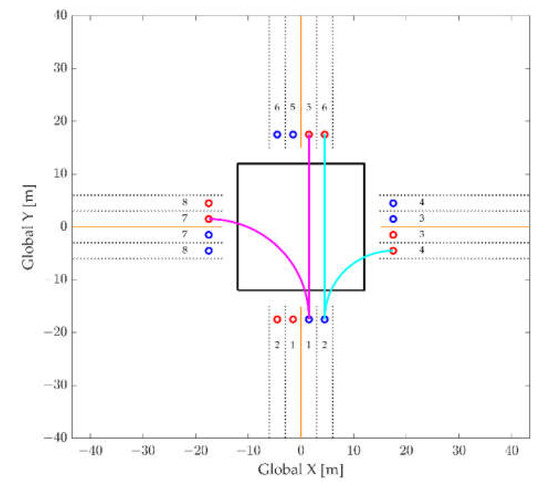
Figure 3.
Example intersection for map building.
3. Target State Decision and Tracking
This study focuses on proactive motion planning for autonomous driving on uncontrolled blind intersections. In other words, determining the appropriate motion to approach an intersection is one of the most important issues of intersection motion planning. Therefore, the approach-motion decision and MPC-based target state tracker will be discussed in this section. The other modules, such as driving mode decision and interaction motion decision, are described in [42]. To briefly explain the driving mode decision, the state machine is designed to activate the approach-motion planning algorithm when the FOV of sensors is restricted by road structures and approaching targets are not detected.
3.1. Target State Decision for Approach Motion
The goal of proactive motion planning is to improve safety by predicting possible risky situations and taking a driving strategy to respond to risky situations. In the case of autonomous driving on uncontrolled blind intersections, the possibility of target vehicles darting out from blind spots is the primary risk even for human drivers. Since the perception system of the autonomous vehicle is relatively more vulnerable to blind spots than humans, the proactive driving strategy is important for carrying out autonomous driving in urban environments. For example, a laser scanner cannot detect the objects behind the closest object on the line of the laser beam. This approach is similar to the driving pattern of experienced drivers who reduce the risk by decelerating in advance in the presence of blind spots.
The first stage in deciding the target state for a proactive approach motion is predicting the crossing point with vehicles darting out from the boundary of the FOV estimate. The crossing point is named the ‘virtual conflict point’ in this study. This is because this point is not an actual conflict point with the detected target, but a possible conflict point. The estimation of sensor FOV is activated after an autonomous vehicle driving in the ‘free driving zone’ enters the ‘proactive zone’. The transition position from the free driving zone to the proactive zone is determined based on the nominal braking distance of the approaching autonomous vehicle. In this study, we use a −2.0 m/s2 as a nominal deceleration to determine the transition position. After an autonomous vehicle enters the proactive zone, FOV is estimated based on the size of the intersection region, the specification of the environment sensors, and the static obstacle map from the perception algorithm [43]. The purpose of the FOV estimation is to find the boundary of the blind spots. Thus, the static obstacle map, by using an occupancy grid, is the most important input of the target state decision. That is, if only the static obstacle map can be constructed, various types of environmental sensors can be used. For example, the FOV estimate can be defined as shown in Figure 4. Based on the FOV estimate and path information from the intersection map, all possible dart-out positions are selected, marked with a red cross in Figure 4. The driving paths from the darting out positions are depicted as red solid lines. The virtual conflict points are defined as intersection points between the driving paths of the autonomous vehicle and possible darting-out vehicles, which are shown in Figure 4 as a blue cross mark.
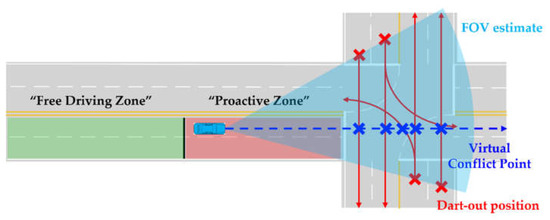
Figure 4.
Virtual conflict point decisions for intersection driving.
The target states for intersection approach motion are determined based on the possible dart-out position and virtual conflict point. The example scenario to explain the target state decision process is depicted in Figure 5, which shows one example of the candidates. First, ddart is defined as the remaining distance to the virtual conflict point in the view of the approaching target vehicle. The remaining time tdart to arrive at the virtual conflict point of the target vehicle is calculated by assuming the dart-out velocity vdart of the target vehicle and dividing the ddart by vdart. vdart is defined as estimated traffic flow velocity [44]. tdart is the remaining time to decelerate the autonomous vehicle to avoid a collision with an approaching target from the blind spots. The target velocity vtarget and braking distance dbrake can be calculated by considering the maximum deceleration ax,min, processing time of the autonomous driving algorithm tproc, actuation delay tact, and slew time tslew. The velocity profile v(t) of the approach motion can be determined based on the uniform jerk motion during slew time and uniform acceleration motion after reaching ax,min as follows:
As mentioned before, autonomous vehicle should be stopped at tdart. Therefore, vtarget and dbrake are defined as follows:
The target distance dtarget is defined by deducing the dbrake from the distance between the host vehicle and the virtual conflict points as shown in Figure 5. The values of each parameter used to calculate vtarget and dtarget are summarized in Table 1 and were derived from the analysis of the smart cruise control actuator of the Hyundai IONIQ electric. The target state decision process is applied to all possible virtual conflict points given in Figure 4. The seven sets of target states were determined in the case of Figure 4.

Table 1.
Parameters for target state decision for approach motion.
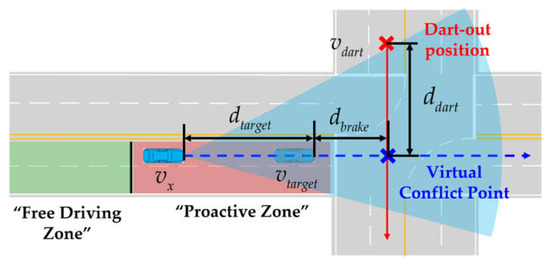
Figure 5.
Target state decision for intersection approach motion.
3.2. Model Predictive Controller-Based Target State Tracker
The target state tracker for approach motion was designed using the MPC. First, the following state and input vectors were used in this study.
where p(k), v(k) and a(k) are the moving distance toward the intersection from the current position, longitudinal velocity and longitudinal acceleration, respectively. ades(k) is the desired acceleration of the autonomous vehicle. k is the prediction time index.
The objective function for the MPC is defined as follows:
The constraints for this problem can be summarized into four categories, dynamic, state, input, and actuator constraints. The first-order model is used to define the dynamic constraint for the MPC problem. The vehicle model is defined with dt, which is the sampling time of the MPC, as follows
The state and input constraints are defined to satisfy the target states as follows:
The actuator constraints are defined based on the actuator performance limit as follows:
where amin, and amax, are the minimum and maximum acceleration, respectively, and ajerk,max is the maximum jerk. The parameters for the MPC-based target state tracker are summarized in Table 2. CVXGEN solver was used to implement the proposed MPC problem in simulation environments [45].

Table 2.
Parameters for target state decision for approach motion.
4. Simulation for Case Study
The safety performance of the proposed motion planner was evaluated through a simulation study. The base algorithm, which was used for the performance comparison with the proposed algorithm, utilized the same driving mode decision and risk management algorithm [42]. However, a proactive motion planner was not applied to the base algorithm. This difference made the autonomous vehicle governed by the base algorithm accelerate to maximum velocity until detection of the target vehicle. In other words, the base algorithm did not have the approach-motion planner.
The intersection for the case study was the four-way uncontrolled intersection. Each road of the intersection intersected at 90 degrees. In addition, structures existed at the boundary of the square intersection area, which created a blind spot for other approach branches. This occlusion restricted the FOV of the environment sensors and delayed the target detection timing. The left turn across path (LTAP) scenario was selected as a case study scenario with the initial position and velocity as shown in Figure 6. The driving routes of the host and target vehicle are marked as a blue and red solid line, respectively. In this simulation, the target vehicle came from the right branch of the driving path of the host vehicle and turned left. This modification of the LTAP scenario increased the risk with the target vehicle by making the target vehicle appear from the blind spot. The initial conditions and parameters for the case study were set as follows:
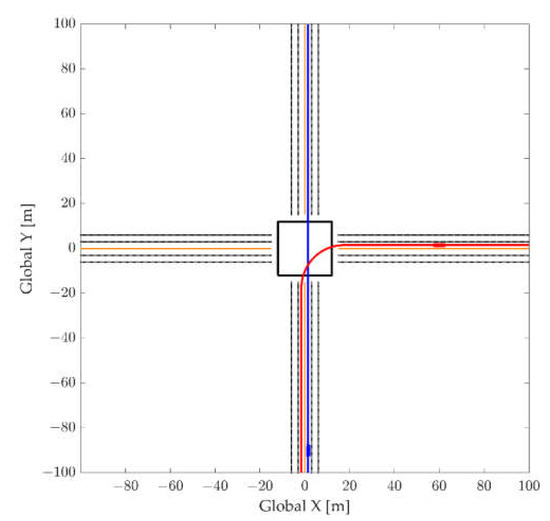
Figure 6.
Initial conditions for simulation based on left turn across path scenario.
The simulation results are summarized as histories of v, a, C, and TTC with respect to dDTI as shown in Figure 7. Histories of C and TTC only appeared when the target vehicle was detected by the host vehicle. Since the dDTI decreased during the simulation, the x-axis of each graph was flipped to improve the graph interpretation. Since the initial condition was configured so that the target vehicle entered the intersection first, the host vehicle should decelerate to avoid collision and yield to the target vehicle. Therefore, the braking motion appeared in the results of both algorithms.
The host vehicle, which is controlled by the base algorithm, accelerated to maximum velocity until detecting the target vehicle at about dDTI = 25 m, as shown in Figure 7a,b. At this moment, the velocity of the host vehicle, 44 km/h, was too fast to react to the target vehicle coming from the blind spot. As shown in Figure 7c,d, C and TTC were already reduced to the risky level, 46 m and 3.9 s, when the approaching target was first detected. This means that the host vehicle should apply maximum braking to avoid or mitigate a collision with the approaching target, as shown in Figure 7b. Even though maximum braking was used, the host vehicle could not stop at the stop line and stopped at dDTI = −3 m. The simulation results from the base algorithm, which did not utilize the proactive motion planner, creating a highly dangerous situation for the driver and the other traffic participants.
Meanwhile, the simulation results from the proposed proactive motion planner showed a more human-like behavior than the base algorithm. As shown in Figure 7a,b, the host vehicle controlled by the proposed algorithm slowly decelerated after the intersection was within the FOV of the sensors, dDTI = 60 m. After the target vehicle was detected at about dDTI = 60 m, a mild deceleration of the average human driver level was applied until the moment when the target vehicle’s entrance to the intersection was confirmed. In this simulation, the interaction motion planner predicted the cross intention of the target vehicle at dDTI = 10 m where the acceleration history started to increase toward a positive value as depicted in Figure 7b. After this moment, the host vehicle accelerated again, even though the target vehicle had not yet passed the conflict point. However, the risk was properly managed as shown in Figure 7c,d. C and TTC were maintained above the safety level even though the host vehicle did not stop at the stop line, which increases the traffic efficiency of the uncontrolled intersections. In short, the simulation results show that the proactive motion planner increases safety and traffic efficiency by achieving similar driving behavior at uncontrolled blind intersections as human drivers.
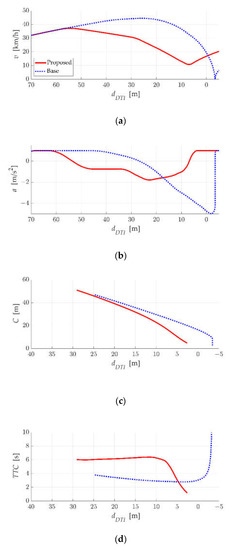
Figure 7.
Simulation results for LTAP scenario. (a) Longitudinal velocity, (b) longitudinal acceleration, (c) clearance to conflict point, (d) TTC to conflict point.
5. Monte Carlo Simulation
The proposed algorithm for approaching motion toward uncontrolled blind intersections was evaluated through the Monte Carlo simulation method. The same intersection used in the case study was utilized in this simulation. However, the numbers of target vehicles were increased from one to five to create a more complex driving situation as shown in Figure 8. The initial position, initial velocity, and maximum velocity of the host and target vehicles were randomly decided using Gaussian distribution as follows:
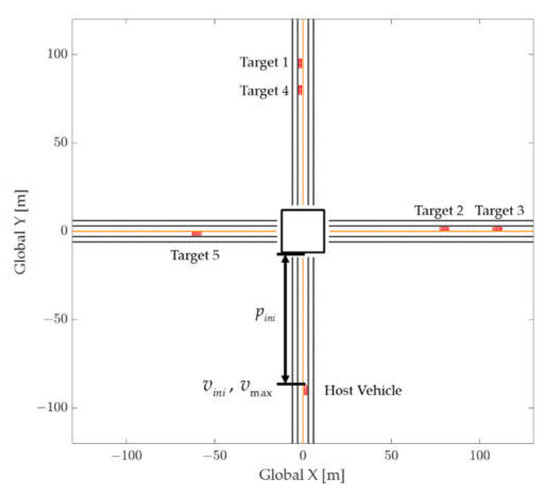
Figure 8.
Multitarget intersection scenario.
The Monte Carlo simulation was conducted 100 times for both algorithms. The Monte Carlo simulation results are summarized in Figure 9, Figure 10, Figure 11 and Figure 12. First, the safety performance of the proposed and base algorithm was analyzed using the TTC and C for intersection scenarios. Figure 9 shows the safety index distribution of the proposed algorithm in two TTC vs. C planes, each plane with colored marks in terms of velocity and acceleration. As can be seen in Figure 9, the proposed algorithm managed the risk caused by various driving situations while maintaining TTC and C above the minimum level, 2 s, and 5 m. In addition, Figure 9a shows that the velocity gradually decreased to zero velocity as the safety index approached the risky region. As shown in Figure 9b, this smooth velocity distribution was derived only using a mild acceleration. In the case of the base algorithm where the proactive motion planner was excluded, Figure 10 shows that a highly dangerous situation occurred even with maximum deceleration. In particular, maximum deceleration was used in most simulation trials because the autonomous vehicle entered the intersection with high velocity. Therefore, the proactive motion planner provided the appropriate approach motion, which improved safety only by using the nominal range of deceleration, as shown in Figure 11, which shows the histogram of the acceleration used.
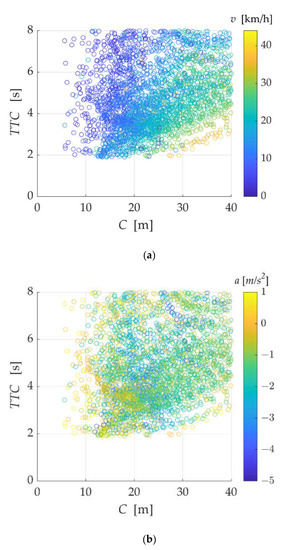
Figure 9.
Safety index distribution of the proposed algorithm. (a) Distribution with respect to longitudinal velocity, (b) distribution with respect to longitudinal acceleration.
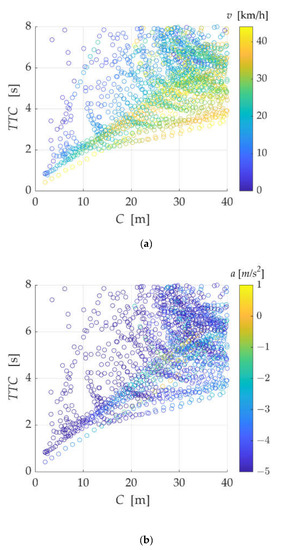
Figure 10.
Safety index distribution of the base algorithm. (a) Distribution with respect to longitudinal velocity, (b) distribution with respect to longitudinal acceleration.
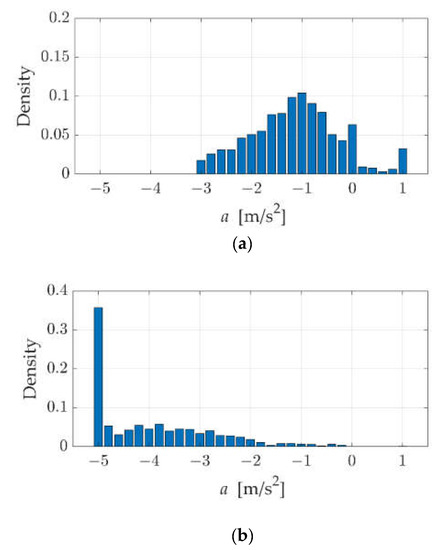
Figure 11.
Histogram of acceleration usage. (a) Proposed, (b) base.
The traffic efficiency of both algorithms was compared based on the time required to cross the intersection. The cumulative number of the simulation times to cross the intersection is depicted in Figure 12. Since the intersection approach velocity of the base algorithm was faster than the proposed algorithm, only a short time was used to cross the intersection in several cases. However, safety was not guaranteed in most cases as mentioned earlier in this section. In addition, excessive deceleration was used and a complete stop frequently occurred in order to avoid collision with targets. Therefore, if the autonomous vehicle lost priority for crossing the intersection, there were cases where the autonomous vehicle could not cross the intersection until all targets passed. In this simulation study, 20 cases could not cross the intersection until the simulation was finished. However, all simulation trials of the proposed algorithm passed the intersection.
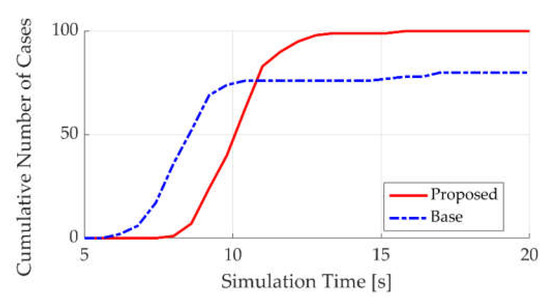
Figure 12.
Simulation time to cross the intersection.
6. Conclusions
A proactive motion planning algorithm for uncontrolled blind intersections was developed and evaluated via Monte Carlo simulation with multitarget vehicle scenarios. The approach-motion planner was designed based on the intersection map and field of view of environment sensors. The target velocity and distance of the approach motion were determined while considering maximum deceleration, the processing time of the autonomous driving algorithm, actuation delay, and slew time. The target state tracker using a model predictive controller was designed to determine the desired longitudinal motion. Simulation studies were conducted to evaluate the proposed algorithm by comparing it with the base algorithm. The simulation results showed that the proactive motion planner increased safety and traffic efficiency by providing a human-like intersection approach motion. Clearance and time to the collision were properly managed only using mild deceleration for various initial conditions. Moreover, the proposed proactive motion planner could be adopted for motion planning for roundabouts or U-turn scenarios. To implement the algorithm for an autonomous vehicle in real driving environments, the robustness of the sensor measurement should be considered. Thus, the future work of the proposed algorithm is the introduction of a robust model predictive control to deal with the uncertainty of the information. In addition, when defining the virtual conflict point, the uncertainty of the target vehicle’s trajectory is also considered. For external factors, the estimation of the sensor’s field of view and the position of the autonomous vehicle is important to determine the desired intersection-approaching motion. Thus, the appropriate perception and localization algorithms are needed to implement the proposed algorithm in autonomous vehicle.
Author Contributions
Conceptualization, S.P. and Y.J.; methodology, Y.J.; software, Y.J.; validation, S.P. and Y.J.; formal analysis, Y.J.; investigation, Y.J.; resources, Y.J.; data curation, S.P.; writing—original draft preparation, S.P.; writing—review and editing, Y.J.; visualization, S.P.; supervision, Y.J.; project administration, Y.J.; funding acquisition, Y.J. All authors have read and agreed to the published version of the manuscript.
Funding
This study was financially supported by Seoul National University of Science & Technology.
Institutional Review Board Statement
Not applicable.
Informed Consent Statement
Not applicable.
Data Availability Statement
All the simulation data were generated during the study at the local computer. Therefore, it cannot be made publicly available for other researchers.
Conflicts of Interest
The authors declare no conflict of interest.
References
- Piao, J.; McDonald, M. Advanced driver assistance systems from autonomous to cooperative approach. Transp. Rev. 2008, 28, 659–684. [Google Scholar] [CrossRef]
- Bengler, K.; Dietmayer, K.; Färber, B.; Maurer, M.; Stiller, C.; Winner, H. Three decades of driver assistance systems: Review and future perspectives. IEEE Intel. Transp. Syst. 2014, 6, 6–22. [Google Scholar] [CrossRef]
- Bagloee, S.A.; Tavana, M.; Asadi, M.; Oliver, T. Autonomous vehicles: Challenges, opportunities, and future implications for transportation policies. J. Mod. Transp. 2016, 24, 284–303. [Google Scholar] [CrossRef]
- Karlaftis, M.G.; Golias, I. Effects of road geometry and traffic volumes on rural roadway accident rates. Accid. Anal. Prev. 2002, 34, 357–365. [Google Scholar] [CrossRef]
- Spek, A.C.E.; Wieringa, P.A.; Janssen, W.H. Intersection approach speed and accident probability. Transp. Res. Part F Traffic Psychol. Behav. 2006, 9, 155–171. [Google Scholar] [CrossRef]
- About Intersection Safety. Available online: https://safety.fhwa.dot.gov/intersection/about/ (accessed on 12 October 2022).
- Scanlon, J.M.; Sherony, R.; Gabler, H.C. Injury mitigation estimates for an intersection driver assistance system in straight crossing path crashes in the United States. Traffic Inj. Prev. 2017, 18, S9–S17. [Google Scholar] [CrossRef]
- Aoude, G.S.; Luders, B.D.; Lee, K.K.H.; Levine, D.S.; How, J.P. Threat assessment design for driver assistance system at intersections. In Proceedings of the 13th International IEEE Conference on Intelligent Transportation Systems, Madeira Island, Portugal, 19–22 September 2010; pp. 1855–1862. [Google Scholar]
- Benmimoun, A.; Chen, J.; Neunzig, D.; Suzuki, T. Communication-based intersection assistance. In Proceedings of the IEEE. Intelligent Vehicles Symposium, Las Vegas, NV, USA, 6–8 June 2005. [Google Scholar]
- Au, T.C.; Zhang, S.; Stone, P. Autonomous intersection management for semi-autonomous vehicles. In Handbook of Transportation; Teodorović, D., Ed.; Routledge: Abingdon, UK, 2015; pp. 88–104. [Google Scholar]
- Zohdy, I.H.; Kamalanathsharma, R.K.; Rakha, H. Intersection management for autonomous vehicles using iCACC. In Proceedings of the 15th International IEEE Conference on Intelligent Transportation Systems, Anchorage, AK, USA, 16–19 September 2012. [Google Scholar]
- Li, G.; Li, S.; Li, S.; Qu, X. Continuous decision-making for autonomous driving at intersections using deep deterministic policy gradient. IET Intell. Transp. Syst. 2021, in press. [CrossRef]
- Song, W.; Xiong, G.; Chen, H. Intention-aware autonomous driving decision-making in an uncontrolled intersection. Math. Probl. Eng. 2016, 2016, 1025349. [Google Scholar] [CrossRef]
- Brechtel, S.; Gindele, T.; Dillmann, R. Probabilistic decision-making under uncertainty for autonomous driving using continuous POMDPs. In Proceedings of the 17th International IEEE Conference on Intelligent Transportation Systems, Qingdao, China, 8–11 October 2014. [Google Scholar]
- Hubmann, C.; Becker, M.; Althoff, D.; Lenz, D.; Stiller, C. Decision making for autonomous driving considering interaction and uncertain prediction of surrounding vehicles. In Proceedings of the 2017 IEEE Intelligent Vehicles Symposium, Los Angeles, CA, USA, 11–14 June 2017. [Google Scholar]
- Shu, K.; Yu, H.; Chen, X.; Chen, L.; Wang, Q.; Li, L.; Cao, D. Autonomous driving at intersections: A critical-turning-point approach for left turns. In Proceedings of the 2020 IEEE 23rd International Conference on Intelligent Transportation Systems (ITSC), Rhodes, Greece, 20–23 September 2020. [Google Scholar]
- Jeong, Y.; Yi, K.; Park, S. SVM based intention inference and motion planning at uncontrolled intersection. IFAC-PapersOnLine 2019, 52, 356–361. [Google Scholar] [CrossRef]
- Schildbach, G.; Soppert, M.; Borrelli, F. A collision avoidance system at intersections using robust model predictive control. In Proceedings of the 2016 IEEE Intelligent Vehicles Symposium, Gothenburg, Sweden, 19–22 June 2016. [Google Scholar]
- de Campos, G.R.; Falcone, P.; Sjöberg, J. Autonomous cooperative driving: A velocity-based negotiation approach for intersection crossing. In Proceedings of the 16th International IEEE Conference on Intelligent Transportation Systems, Hague, The Netherlands, 6–9 October 2013. [Google Scholar]
- Lu, G.; Li, L.; Wang, Y.; Zhang, R.; Bao, Z.; Chen, H. A rule based control algorithm of connected vehicles in uncontrolled intersection. In Proceedings of the 17th International IEEE Conference on Intelligent Transportation Systems, Qingdao, China, 8–11 October 2014. [Google Scholar]
- Zhang, H.; Zhang, R.; Chen, C.; Duan, D.; Cheng, X.; Yang, L. A priority-based autonomous intersection management (AIM) scheme for connected automated vehicles (cavs). Vehicles 2021, 3, 533–544. [Google Scholar] [CrossRef]
- Zhang, Y.; Hao, R.; Zhang, T.; Chang, X.; Xie, Z.; Zhang, Q. A Trajectory Optimization-Based Intersection Coordination Framework for Cooperative Autonomous Vehicles. IEEE Trans. Intell. Transp. Syst. 2021, 23, 14674–14688. [Google Scholar] [CrossRef]
- Li, Y.; Liu, Q. Intersection management for autonomous vehicles with vehicle-to-infrastructure communication. PLoS ONE 2020, 15, e0235644. [Google Scholar] [CrossRef]
- Peng, B.; Keskin, M.F.; Kulcsár, B.; Wymeersch, H. Connected autonomous vehicles for improving mixed traffic efficiency in unsignalized intersections with deep reinforcement learning. Commun. Transp. Res. 2021, 1, 100017. [Google Scholar] [CrossRef]
- Castiglione, L.M.; Falcone, P.; Petrillo, A.; Romano, S.P.; Santini, S. Cooperative intersection crossing over 5G. IEEE/ACM Trans. Netw. 2020, 29, 303–317. [Google Scholar] [CrossRef]
- Chen, Y.; Zha, J.; Wang, J. An autonomous T-intersection driving strategy considering oncoming vehicles based on connected vehicle technology. IEEE ASME Trans. Mechatron. 2019, 24, 2779–2790. [Google Scholar] [CrossRef]
- Medina, A.I.M.; van de Wouw, N.; Nijmeijer, H. Cooperative intersection control based on virtual platooning. IEEE trans. Intell. Transp. Syst. 2017, 19, 1727–1740. [Google Scholar] [CrossRef]
- Bichiou, Y.; Rakha, H.A. Developing an optimal intersection control system for autonomous connected vehicles. IEEE trans. Intell. Transp. Syst. 2018, 20, 1908–1916. [Google Scholar] [CrossRef]
- Duan, X.; Jiang, H.; Tian, D.; Zou, T.; Zhou, J.; Cao, Y. V2I based environment perception for autonomous vehicles at intersections. China Commun. 2021, 18, 1–12. [Google Scholar] [CrossRef]
- Batkovic, I.; Zanon, M.; Ali, M.; Falcone, P. Real-time constrained trajectory planning and vehicle control for proactive autonomous driving with road users. In Proceedings of the 2019 18th European Control Conference, Naples, Italy, 25–28 June 2019. [Google Scholar]
- Yen, Y.T.; Chou, J.J.; Shih, C.S.; Chen, C.W.; Tsung, P.K. Proactive Car-Following Using Deep-Reinforcement Learning. In Proceedings of the 23rd International Conference on Intelligent Transportation Systems, Rhodes, Greece, 20–23 September 2020. [Google Scholar]
- Morales, Y.; Yoshihara, Y.; Akai, N.; Takeuchi, E.; Ninomiya, Y. Proactive driving modeling in blind intersections based on expert driver data. In Proceedings of the 2017 IEEE Intelligent Vehicles Symposium, Los Angeles, CA, USA, 11–14 June 2017. [Google Scholar]
- Zhu, F.; Ukkusuri, S.V. Modeling the proactive driving behavior of connected vehicles: A cell-based simulation approach. Comput-Aided Civ. Inf. Eng. 2018, 3, 262–281. [Google Scholar] [CrossRef]
- Poncelet, R.; Verroust-Blondet, A.; Nashashibi, F. Safe geometric speed planning approach for autonomous driving through occluded intersections. In Proceedings of the 2020 16th International Conference on Control, Automation, Robotics and Vision (ICARCV), Shenzhen, China, 13–15 December 2020. [Google Scholar]
- Okamoto, M.; Perona, P.; Khiat, A. Ddt: Deep driving tree for proactive planning in interactive scenarios. In Proceedings of the 21st International Conference on Intelligent Transportation Systems, Maui, HI, USA, 4–7 November 2018. [Google Scholar]
- Li, N.; Yao, Y.; Kolmanovsky, I.; Atkins, E.; Girard, A.R. Game-theoretic modeling of multi-vehicle interactions at uncontrolled intersections. IEEE Trans. Intell. Transp. Syst. 2020, 23, 1428–1442. [Google Scholar] [CrossRef]
- Isele, D.; Rahimi, R.; Cosgun, A.; Subramanian, K.; Fujimura, K. Navigating occluded intersections with autonomous vehicles using deep reinforcement learning. In Proceedings of the 2018 IEEE International Conference on Robotics and Automation, Brisbane, QLD, Australia, 21–25 May 2018. [Google Scholar]
- Guan, Y.; Ren, Y.; Ma, H.; Li, S.E.; Sun, Q.; Dai, Y.; Cheng, B. Learn collision-free self-driving skills at urban intersections with model-based reinforcement learning. In Proceedings of the 2021 IEEE International Intelligent Transportation Systems Conference (ITSC), Indianapolis, IN, USA, 19–22 September 2021. [Google Scholar]
- Al-Sharman, M.; Dempster, R.; Daoud, M.A.; Nasr, M.; Rayside, D.; Melek, W. Self-Learned Autonomous Driving at Unsignalized Intersections: A Hierarchical Reinforced Learning Approach for Feasible Decision-Making. TechRxiv 2022, 14, 1–11. [Google Scholar]
- Hoel, C.J.; Tram, T.; Sjöberg, J. Reinforcement learning with uncertainty estimation for tactical decision-making in intersections. In Proceedings of the 2020 IEEE 23rd International Conference on Intelligent Transportation Systems (ITSC), Rhodes, Greece, 20–23 September 2020. [Google Scholar]
- Kai, S.; Wang, B.; Chen, D.; Hao, J.; Zhang, H.; Liu, W. A multi-task reinforcement learning approach for navigating unsignalized intersections. In Proceedings of the 2020 IEEE Intelligent Vehicles Symposium (IV), Las Vegas, NV, USA, 19 October–13 November 2020. [Google Scholar]
- Jeong, Y.; Yi, K. Target vehicle motion prediction-based motion planning framework for autonomous driving in uncontrolled intersections. IEEE trans. Intell. Transp. Syst. 2019, 22, 168–177. [Google Scholar] [CrossRef]
- Lee, H.; Yoon, J.; Jeong, Y.; Yi, K. Moving Object Detection and Tracking Based on Interaction of Static Obstacle Map and Geometric Model-Free Approach for Urban Autonomous Driving. IEEE trans. Intell. Transp. Syst. 2020, 22, 3275–3284. [Google Scholar] [CrossRef]
- Chae, H.; Jeong, Y.; Lee, H.; Park, J.; Yi, K. Design and implementation of human driving data–based active lane change control for autonomous vehicles. Proc. Inst. Mech. Eng. D 2021, 235, 55–77. [Google Scholar] [CrossRef]
- Mattingley, J.; Boyd, S. CVXGEN: A code generator for embedded convex optimization. Optim. Eng. 2012, 13, 1–27. [Google Scholar] [CrossRef]
Publisher’s Note: MDPI stays neutral with regard to jurisdictional claims in published maps and institutional affiliations. |
© 2022 by the authors. Licensee MDPI, Basel, Switzerland. This article is an open access article distributed under the terms and conditions of the Creative Commons Attribution (CC BY) license (https://creativecommons.org/licenses/by/4.0/).